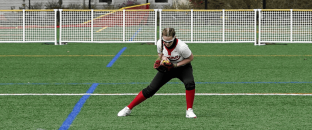*Note: products listed on Bases Loaded Softball are selected by our softball players, coaches, and team of enthusiast writers and editors. Buying softball products through our links may earn us a commission with no additional cost to you.
A drop ball is one of the first pitches you should learn in softball, and possibly the most important. The purpose of the drop ball is to pitch the ball so that it flies directly towards the pitcher, then at the last moment, makes a sharp downwards turn towards the ground.
The reason this pitch is so important is because it gives a pitcher control over the game. If the bases are loaded, for example, you will want to pitch the ball in a way that will send it low towards the ground if it makes contact with the batter’s bat. This will allow you to more quickly regain control of the ball so you can get to any runners on second or third base, before they have a chance to make it home.
The drop ball is also just a great pitch that, if done successfully, can be used to get outs on the batter. And since gravity is on your side, this pitch is not as difficult as others, like the rise ball.
However, make sure that you only move on to learning the drop ball after you’ve already mastered the fastball. The reason for this is that if you cannot yet throw the ball 50-60 mph, it will not have enough speed to make the ball break towards the ground, which happens due to a combination of spin and velocity. So, master your fastball, then move on to the drop ball. (Some coaches prefer to teach the changeup before moving onto the fastball, but this is a personal preference).
How to throw a drop ball in softball (mastering your form):
There are two types of drop ball in softball: the peel drop ball, and the turn over drop ball. Regardless of which type you want to throw, there are four important component in a pitcher’s form that will determine whether or not you can pull it off: posture, release, spin, and follow through. Some of these factors will change depending on whether you’re throwing a “peel drop ball” or a “turn over drop ball.” Read below to learn the proper form for each of these types of drop ball.
How to throw a peel drop ball:
Spin: For this pitch, you will want to make your softball spin forwards. Unlike the rise ball, where you’re trying to make the ball move upwards and therefore put backspin on the ball, the drop ball requires a forwards spin. This will cause the ball to break downwards when it spins against the air at high velocities. Hold the ball across all four seams, with your fingertips touching the seems at all times. For beginners, your fingers should be fairly evenly spread. For the advanced method, push your fore finger and middle finger together so that they create a V shape with your ring finger.
Posture: Stand so that your body weight is resting on your stride foot. For the drop ball, your stride is going to be slightly shorter than it is when throwing a fastball. When releasing the ball, lean your whole body forward—not just at the waist, but your whole body—so that your body is on an angle facing the ground, where you want the ball to go. Remember, where your head goes your body follows. And where your body goes, the ball will go. So angle your body forwards so that the ball moves in the same direction.
Release: When releasing the ball, you should allow the ball to peel off your fingertips so that your thumb releases first, and your middle finger last. You’re not quite snapping up with your fingertips, which would put spin on the ball but would also send it upwards instead of downwards. Instead, you’re just angling your fingertips downwards towards the catcher’s glove and allowing the ball to peel off them to put a forward spin on the ball.
While you should be gripping the ball with the same circle as your fastball, you should pull your elbow back as you release the ball, jerking it backwards just as the ball exits your hand. You should also release the ball just a little earlier than you would for your fastball. Upon release, your wrist should also be bent backwards, so that when you release the ball, you’re putting a forward spin on it.
Follow through: While following through, your arm should be at about a 100 degree angle, and your fingers pointing slightly down towards the catcher’s glove.
How to throw a turn over drop ball:
Spin: For this pitch, you will want to make your softball spin forwards. Unlike the rise ball, where you’re trying to make the ball move upwards and therefore put backspin on the ball, the drop ball requires a forwards spin. This will cause the ball to break downwards when it spins against the air at high velocities. Hold the ball across all four seams, with your fingertips touching the seems at all times. For beginners, your fingers should be fairly evenly spread. For the advanced method, push your fore finger and middle finger together so that they create a V shape with your ring finger.
Posture: Stand so that your body weight is resting on your stride foot. For the drop ball, your stride is going to be slightly shorter than it is when throwing a fastball. When releasing the ball, lean your whole body forward—not just at the waist, but your whole body—so that your body is on an angle facing the ground, where you want the ball to go. Remember, where your head goes your body follows. And where your body goes, the ball will go. So angle your body forwards so that the ball moves in the same direction.
Release: When releasing the ball, your wrist should quickly snap around so that your hand goes from being under the ball to over the ball. In other words, while your thumb will start over the ball and your fingers under it, as you’re just preparing to release the ball, your thumb should swing around under the ball, while your pointer finger and index finger quickly snap around over the ball, so that the inside of your fingers are facing back towards your right thigh as the ball leaves your hand.
Follow through: Follow through so that your whole body is angled slightly forwards towards the catcher’s glove. To help with this follow through, you can position yourself so that your back toe is pointed back into the ground as you land back on your stride foot.
How to throw a drop ball in softball (drills to practice the drop ball):
Before you start your drills, first take a moment to familiarize yourself with the hand and wrist motions you will need to male upon releasing the ball. These motions are described below. After you’ve got that down, move on to the drills, which work great for learning the drop ball whether you’re doing a peel or turn over drop.
Before you begin your peel drop ball drill: Begin in the open position. Extend your arm out infront of you, with the ball in your hand. Then, jerk your arm back so that the ball rolls off your fingers and up into the air. The objective is to have the ball fly upwards while spinning forwards, then come back down and land in your hand. Try to see how fast you can get the ball spinning forwards. Have a coach or trusted player watch your technique so you can make adjustments to your form.
Before you begin your turn over drop ball drill: Hold the ball in your hand with proper form at your side. Your fingers should be beneath the ball, while your thumb is over top. Quickly snap your hand around so that your fingers come over top of the ball and your thumb beneath it, as described in the “release” section above. Allow the ball to release as your hand finishes its snap so the it drops to the ground. Essentially, you’re trying to get the release method down before you try executing it quickly in an actual pitch.
Drill #1: Stand back from the plate about 10 feet from where you would normally be. No need to have a catcher in place just yet. Just try pitching the drop ball so that it hits the ground about 10 feet in front of the home plate. Do not worry about sending the ball into the zone where the catcher’s glove will be just yet. First, you want to practice this way to perfect your release and forward-leaning posture as you follow through.
Drill #2: Set up a horizontal rope 8 feet in front of the home plate so that it’s taught and suspended 12 inches above the ground. You can set up this rope using metal poles, rods, broom handles, or any other kind of long, straight stick-like object that can be stuck into the ground and used to tie a rope to. Then, pitch the ball so that it flies overtop of the rope, then breaks down and lands in the catcher’s glove behind the home plate, slightly below the height of the rope. If you can pull this off, it means you are successfully making the ball break downwards as it approaches the plate.
When to use the drop ball:
The drop ball is a great pitch to use in a variety of circumstances. Oftentimes, the objective of a drop ball is simply to achieve a ground out on the batter. However, the drop ball is also the perfect pitch to use if you notice that the batter is holding their bat too high.
Another important use for the drop ball is when there are runners on second and third base. Since drop balls are close to the ground, if the batter does connect with the ball, chances are the ball will stay low to the ground, rather than popping high into the outfield. When there are runners on second and third base, it’s essential to keep the ball in the infield so that your infield catchers can get it quickly, and try to get the runners out before they make it home.
Finally, a drop ball is good to use if you’re struggling to keep your fastballs low enough in the zone to achieve an out.









